Abstract
Polyethylene (PE) gas pipes can be jointed together by electrofusion PE fittings, which have sockets that are fused onto the pipe. Additionally, electrofused PE patches can be used to repair defected pipes. When these pipelines are buried under the ground, they can experience sever local stresses due to the presence of pipe joints, which is superimposed on the other effects including the soil-structure interaction, traffic load, soil’s column weight, a uniform internal pressure, and thermal loads imposed by daily and/or seasonal temperature changes. The present contribution includes two cases. At first, stress variations in buried polyethylene gas pipe and its socket due to the aforementioned loading condition is estimated using finite element. The pipe is assumed to be made of PE80 material and its jointing socket material is PE100. Afterward, the effects of aforementioned thermo-mechanical loads on the stress distribution in patch repaired buried pipes are well investigated. The soil physical properties and the underground polyethylene pipe installation method are based on the American association of state highway and transportation officials and American society for testing and material standards. The computer simulation and analysis of stresses are performed through the finite element package of ANSYS Software. Stress concentrations can be observed in both components due to the presence of the socket or the repair patch. According to the results, the electrofusion sockets can be used for joining PE gas pipes even in hot climate areas. The maximum values of these stresses happen to be in the pipe. Also, the PE100 socket is more sensitive to a temperature drop. Additionally, all four studied patch arrangements show significant reinforcing effects on the defected section of the buried PE gas pipe to withstand applied loads. Meanwhile, the defected buried medium density polyethylene (MDPE) gas pipe and its saddle fused patch can resist the imposed mechanical and thermal loads of +22 °C temperature increase.
1. Introduction
Petroleum, natural gas, and condensates are naturally occurring substances which are discovered within the Earth’s crust, are thought to originate from decomposed animal and plant matter. Scientists believe the plants and animals died in the distant past, and were gradually buried by thick layers of sediments. Over a long period of time, and with pressure and temperature, the organic materials were transformed into the oil and gas which are found today. When oil and gas are removed from the ground they are sent to refineries by pipelines. Then, many products from these materials, which potentially contain several chemicals called hydrocarbons, can be obtained including energy for power, motor oil, gasoline for cars, diesel fuel for trucks and trains, hi-octane fuels for planes, heating oil for houses etc. Several other materials also come from petroleum such as plastics, asphalt, grease, lubricating oil, materials for clothes, chemicals for everyday use, paints etc. Since oil has natural gas in it, when oil is produced often some gas is produced with the oil if natural gas is in the solution. The majority of oil is trapped in the tiny pore spaces between grains of rock or sand. Oil and gas are discovered in natural traps which consist of domes or faults within the earth. Impermeable rock above the trap that fluid cannot pass through it stops the oil and gas from move up to the surface. Without traps, the oil and gas could migrate all the way to the surface and evaporate. Figure 1 shows an example of an oil reservoir with a gas cap.
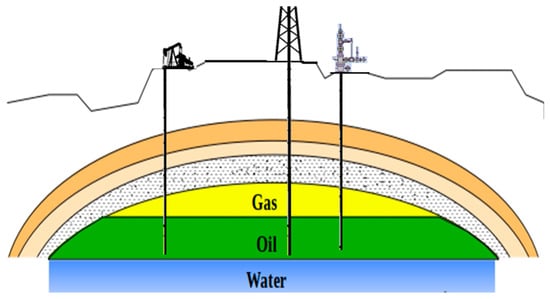
Figure 1.
An example of an oil reservoir with a gas cap.
After geophysicists find reservoirs and process the data to construct pictures of what the earth looks like underground, drilling companies start to drill into the proposed reservoirs. A drilling rig is a package of special equipment put together that enables us to create a hole to a projected depth for producing oil or natural gas [1,2,3,4]. Finally, the well is produced into a pipeline, which takes it to production facilities on surface. The production facilities on surface separate out the gas, oil, and water into their separate phases. From there, the oil and gas may be refined further before being ready to market. Finally, the gas and oil can be sold to power cars and heat houses.
High density (HD) and medium density (MD) polyethylene materials are often used to produce gas pipes. A pipeline network needs a long length pipe to dispatch natural gas. It is troublesome to produce long pipes, hence the needed lengths of pipe is assembled by connecting short pipes together. Additionally, in order to construct long pipe networks, it is essential to utilize joining methods such as butt-welding, electro-fusion, mechanical joining etc. Mainly, electro-fusion joint is extensively employed since it is empirically feasible to perform even in areas where access is restricted. Generally, buried pipes are divided into two categories: flexible pipes, where the pipe deforms under applied loads at least 2 percent of the pipe diameter without any effect to the pipe material, and rigid pipes, where the pipe structure changes (for example with crack creation) in the mentioned deformation [5]. PE pipes behave as flexible pipes when installed underground. In the underground application of PE pipes, the installation procedure and the design method are of great importance for natural gas distributor companies. The first step in buried pipe design is to determine the soil dead load and surcharge loads on the pipe and ensure the safe operation of the PE pipes for a long period of time. The load resulted from soil column weight, vehicle wheel, pipe internal pressure, and daily or seasonal temperature changes which induced horizontal and vertical deflections along with significant stresses in the pipe wall. Consequently the soil showed reaction to the aforementioned pipe action and will limit the pipe deflection. Several experimental and analytical methods have been proposed by researchers to calculate the applied loads, deflections, and stresses on the buried pipes that, although suitable for most underground applications, do not produce accurate results [6]. The modern buried-pipe design was proposed by Marston from Iowa University in the early 20thcentury [6,7]. Spangler continued theoretical studies on flexible buried pipes by assuming soil and pipe as linear elastic materials and proposed Iowa’s modified formula to predict deflection in flexible buried pipes [7]. Afterward flexible pipe materials including aluminum, polyvinyl, and polyethylene were used in underground applications to improve pipe-soil behavior and reduce costs. Pipe-soil interaction is a combination system that significant share of the applied load is carried by the soil around the pipe which makes it difficult to calculate the induced stresses in the pipe material. One of the strongest numerical approaches to investigate underground structure responses to the applied loads is the finite element method. Abaqus and Ansys software has been used by several researchers for three-dimensional modeling of the aforementioned structures. In this research, the methods discussed in contributions on finite element modeling of buried polyethylene gas pipes which can be found in references [8,9,10,11,12,13] are used to further investigate the stress distribution in special cases of buried polyethylene gas pipe problems which are subjected to the local geometry changes compared to simple buried pipes. This study can be divided in two parts. In the first part, the case of joining buried PE pipes by electrofusion socket joints is well discussed. In the second part of the research, four different patch arrangements used to repair defected buried pipes are investigated, and their reinforcing effects on damaged parts are discussed. The pipe, socket/patch, the soil grades surrounding them, and the underground installation procedure and burial depth are all selected based on the standards commonly used in gas distribution companies. For both cases, the simultaneous effects of mechanical loads including pipe internal pressure, vehicle traffic load, soil column load, and more critical thermal loads of temperature variations in PE pipe and its socket/patch on the induced stresses in PE80 pipe and PE100 socket/patch materials are investigated using Ansys software. In both cases when the model is imposed to the aforementioned thermo-mechanical loads, stress concentrations will appear in the pipe and its socket/patch due to local changes in the pipe geometry.
2. Basic Design Theory
In engineering design, soil classification systems for structural applications are based on soil mechanical and physical properties including grain sizes. Commonly, AASHTO and ASTM standards are used as guides for these purposes [5,14]. The investigation of structural behavior of underground systems starts with the determination of applied loads. The design of underground structures is in accordance with the principle of soil-pipe interaction. Estimating the loads on structures, including gas pipelines used in underground space, depends on the pipe installation procedure in the trench that can be found in ASTM D 2321 standard [15,16]. The mechanical properties of the backfill environment or embedment should meet the special structural application. The mechanical properties of the soil grades used for bedding, haunching, initial and final backfill and also asphalt cover, along with installation dimensions are selected based on references [8,9,10,11]. Additionally similar loading conditions are introduced and imposed.
3. Stress Investigation in Socket Joint of Buried Polyethylene Gas Pipe
The socket material for joining MDPE buried gas pipes was selected from the PE100. Based on references [8,9,10,11] PE80 material was selected for the pipe. In order to investigate the stress distribution in a pressurized PE gas pipe, the value of 11 was selected for pipe and its socket SDR (Standard dimension ratio) Geometrical and mechanical properties of PE100 socket material are presented in Table 1 [17].

Table 1.
Geometrical and mechanical properties of PE100 socket.
The type of the joining is electro fused socket where the related dimensions are presented in Figure 2.

Figure 2.
Selected socket geometry and dimensions for the investigated PE pipe [18]. D: Socket inside diameter; T: Inner length; L: Socket length; H: Socket height.
Generally, PE100 material is the proper option to join PE80 pipes. PE100 material has the minimum allowable stress of 10 MPa for a working life of 50 years in 20 °C design temperature. In contrast, the minimum allowable stress for PE80 material for a working life of 50 years in 20 °C design temperature is as low as 8 MPa. PE100 material shows better resistance against perforation than PE80 material. Additionally, PE100 material shows better resistance to fast crack propagation in comparison to PE80 material. This means if a crack initiates in a PE100 material, it will stop propagating in a short length. This advantage is of great importance especially for pipes loaded under high pressure values that fast crack propagation is of magnificent importance. PE100 material shows good behavior against creep rupture compared to PE80 material. Additionally, for two different PE100 and PE80 pipes with the same SDR, PE100 pipe material can be used for higher pressure values. That means with the same inside pressure for PE100 and PE80 pipe material, the wall thickness of PE100 pipe material can be chosen 19% less than that of PE80 pipe material [19].
To investigate the stress distribution in the socket the simultaneous effects of soil column weight, traffic wheel load, pipe and socket temperature changes, internal pressure are considered and implemented in ANSYS (V12, ANSYS, Pittsburgh, PA, USA) software. Figure 3 illustrates a typical finite element model of pipe and socket subjected to internal pressure. It should be noted that the dimension of the model upper surface is x = 1.5 m and z = 1.5 m. Furthermore, because of the identical effect of the concentrated and distributed wheel load in the selected installation depth, the effect of distributed wheel load on the pipe and its socket is investigated. Additionally the soil-pipe interaction is also incorporated in the model by using face-to-face contact elements (conta 172 and target 170).
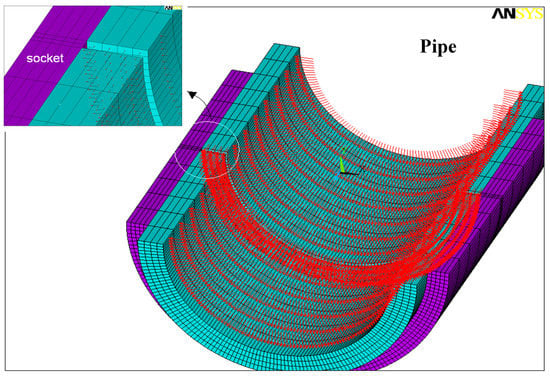
Figure 3.
Typical finite element model of pipe and socket subjected to internal pressure.
4. Evaluation of the Results
As previously mentioned, the effect of traffic load, soil weight, temperature changes, internal pressure, and the presence of the local changes in the pipe geometry were all included to investigate their overall effects on the stress distribution in the buried PE80 pipe and its related socket joint from PE100 material. For the following section of this research, the value of 1.5 is selected for the design coefficient (factor of safety). Considering the operating temperature of 35 °C for underground pipes buried at a depth of 125 cm, based on climate conditions in hot areas and Ahvaz city [8,9,10,11,12,13,20], according to the reported minimum strength value for polyethylene PE100 material [21], the design stress (maximum allowable stress) for this research is 5.4 MPa. Additionally, this value of design stress is calculated to be 4.3 MPa for the PE80 pipe material. In all stages of the next section of this investigation, the mentioned values are considered as the maximum applicable stresses on the pipe.
4.1. Results of Finite Element Solution for the Socket Jointed Buried Pipe
In this section, various thermal and mechanical loadings applied to the buried socket jointed polyethylene gas pipe during the operation period are considered to be software inputs, and the resulting induced stresses are evaluated and discussed using finite element method.
The geometry and the installation procedure of the socket jointed polyethylene pipe are similar to that of normally buried polyethylene pipe which is well described [8,9,10,11,12]. Therefore, the same temperature variations for the buried pipe impose to the socket too.
The finite element results for maximum values of Von Mises and axial stresses under the simultaneous effects of the soil column weight, pipe internal pressure, vehicle wheel load and temperature variations of +5 °C, −15 °C and 0 °C (no variation) in the buried pipe and its socket are calculated and presented in Table 2.The maximum axial stress and the maximum Von Mises stress values in the wall of buried socket joint of the gas distribution pipe under the simultaneous effect of mechanical loads including soil load, internal pressure, vehicle wheel load and thermal loads in the form of maximum temperature drop of 15 °C and increase of 5 °C are calculated and plotted in Figure 4. For Figure 4, the coordinate system is selected so that the origin of the horizontal axes represents the socket internal surface and the stress variations are plotted from the origin to the socket crown. As expected, the upper curves pertain to the temperature decrease. Additionally, the dashed curve indicates the allowable stress value for design temperature of 35 °C based on a 50-year life expectancy for the pipe and socket material. Additionally the Von Mises stresses variations are plotted from the socket internal surface to its crown.

Table 2.
The simultaneous effect of soil column pressure, pipe internal pressure, vehicle wheel load, and temperature variations.
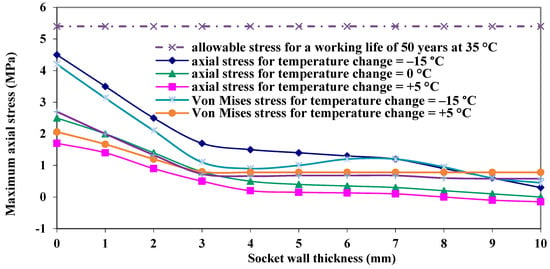
Figure 4.
Maximum axial and Von Mises stress variations in the wall of buried socket joint (the simultaneous effect of soil load, internal pressure, vehicle wheel load and temperature variations).
Figure 5 shows the simultaneous effect of the aforementioned mechanical and thermal loads on the maximum axial and the maximum Von Mises stresses along the socket length of the buried polyethylene gas pipe. The origin of the horizontal axis is supposed to be the socket center. As the result of the geometry and loading symmetry, only the stress values of half of the socket are presented. Similarly, the dashed line is for the allowable stress values for the material of PE100. Additionally, maximum axial stress variations and maximum Von Mises stress variations along the half of pipe length under the simultaneous effect of soil load, internal pressure, and vehicle wheel load and temperature variations are calculated and plotted as Figure 6.
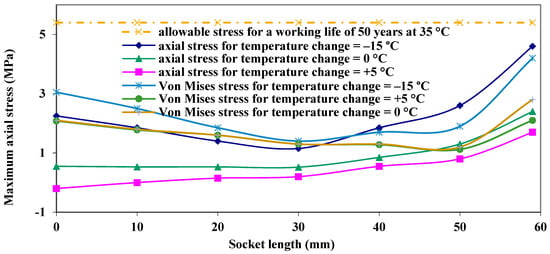
Figure 5.
Maximum axial and Von Mises stress variations along the socket length (the simultaneous effect of soil load, internal pressure, vehicle wheel load and temperature variations).
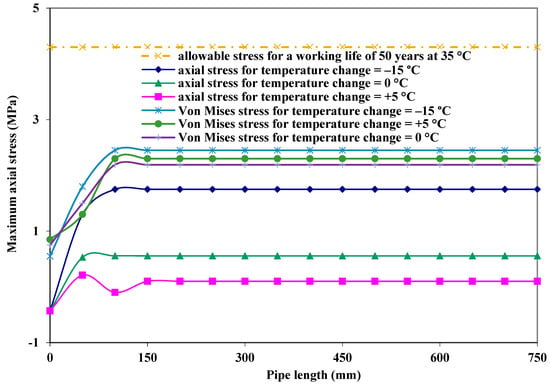
Figure 6.
Maximum axial and Von Mises stress variations along the pipe length (the simultaneous effect of soil load, internal pressure, vehicle wheel load and temperature variations).
Considering the presented maximum stress results in Table 2 and Figure 4, Figure 5 and Figure 6 it can be concluded that:
- A daily temperature rise of +5 °C decreases the maximum axial stresses in the socket joint from 2.52 MPa to 1.74 MPa which is about 31% and additionally decreases the maximum axial stresses in the pipe from 0.56 MPa to 0.21 MPa which is about 63%.
- A daily temperature rise +5 °C decreases maximum Von Mises stresses in the socket joint from 2.6 MPa to 2.11 MPa which is about 19% and additionally increases maximum Von Mises stresses in the pipe from 2.19 MPa to 2.30 MPa which is about 3.8%.
- A daily temperature drop of −15 °C increases maximum axial stresses in the socket joint from 2.52 MPa to 4.14 MPa which is about 64% and additionally increases maximum axial stresses in the pipe from 0.56 MPa to 1.86 MPa which is about 235%.
- A daily temperature drop of −15 °C increases maximum Von Mises stresses in the socket joint from 2.60 MPa to 4.50 MPa which is about 73% and additionally increases maximum Von Mises stresses in the pipe from 2.19 MPa to 2.45 MPa which is about 12%.
- According to the Figure 4, Figure 5 and Figure 6, in all cases the maximum values for both axial and Von Mises stresses occurs at the middle of the socket internal surface while the minimum values of the aforementioned stresses in the socket occur where the internal surface of the socket joins the pipe outer surface.
After investigating the effect of socket joints, in the next section the effect of patch repair is well studied by finite element method.
4.2. Results of Finite Element Solution for the Patch Repaired Pipe
Engineering structures bear or transfer several loads and may be defected during their lifetime due to several reasons. An understanding of fracture mechanisms plays an important role in structural materials safe design. Therefore several numerical methods have been used to investigate and model fracture in materials [22,23,24,25,26,27,28,29,30,31,32,33,34,35,36,37,38,39,40]. The calculation of stress distribution in a damaged underground polyethylene gas pipe using finite element modeling was well discussed in [9], where several circular and elliptical shaped defects with various circular hole diameter and ellipse hole diameter ratios a/b, were modeled at the pipe crown. Additionally, the effect of 4 types of polyethylene patch repair arrangements on the stress reduction in the aforementioned defected pipes was well investigated by the computational modeling and analysis tools of ANSYS software [10]. In the following, we continued the study in references [9,10] to investigate the buried PE pipe with more details and under more critical loading conditions. The finite element code is used for modeling and analysis of the pipe, patch and their surrounding and since stress distribution in the pipe wall is very important, 3D brick-type SOLID95 elements, available in the ANSYS software package elements library, are well employed to model the physical medium. The SOLID95 element has three degrees of freedom at each node (translations in the x, y, and z coordinate directions) that makes it very suitable for solving curved boundary problems. Additionally, to have the best mesh control with a minimal number of finite elements and to reduce the computational time and costs, the mapped (structured) finite element mesh which typically has a regular pattern, is performed to control the mesh efficiency. In this research we study the stress reduction effects on defected polyethylene gas pipes reinforced by polyethylene patches under sever thermo-mechanical loads for four various patch arrangements including semi-cylindrical, circular-partial, square-partial and saddle fusion patches to find the optimum patch shape. For the purpose of finding an appropriate patch shape and geometry, identical thickness (4.763 mm), inside diameter (114.3 mm) and material properties (PE 100) are considered for all patch types. It is assumed that the pipe and patch materials behave as linear elastic and have isotropic properties. A typical pipe-patch arrangement (saddle fusion patch) and related dimensions can be found on Figure 7. Additionally, the pipe and patch material mechanical properties can be found on Table 3.
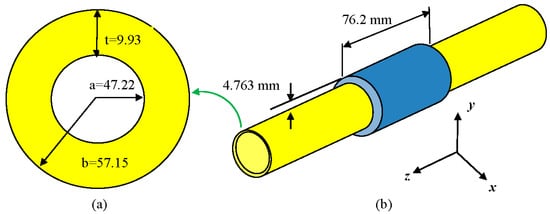
Figure 7.
Polyethylene pipe and patch arrangement. (a) Two dimensional view (dimensions in mm) of the cross section of the medium density polyethylene gas pipe. (b) Three dimensional model of patch repaired pipe showing patch dimensions [8,9,10,11,12,41].

Table 3.
Mechanical properties of the PE80 pipe and PE100 patch materials [8,9,10,11,12,41].
In the next section we investigate the aforementioned models with more details by superimposing various thermal loads in the form of temperature variations to the mechanical loads including surcharge loads, soil column weight, soil-pipe interaction, and inside pressure of 4 bar applied to the repaired defected polyethylene pipe and its patch. The results of previous section show that the maximum Von Mises stress values are well below the allowable stresses (based on the design factor of 1.5) for working life of 50 years at 35 °C. Additionally lower values of safety factor (design factor) are applicable to design underground gas pipes. By selecting the value of 1.25 for safety factor, the values of allowable stresses for working life of 50 years at 35 °C will be 5.2 MPa and 6.5 MPa for PE80 pipe and PE100 patch materials respectively. We prefer to use these values for the following section of the research.
Before starting to investigate the complicated case of underground problem and soil-structure interaction for buried patch repaired polyethylene gas pipe, we perform verification by finite element modeling of the patch repaired PE pipe not buried under the ground and only loaded to a final internal pressure of 4 bars. The results are well described in the following section.
4.2.1. Finite Element Modeling and Solution for an Unburied Patch Repaired Pipe with Circular Wall Holes
In this section, we use finite element modeling to evaluate stress distribution in a defected unburied MDPE gas pipe that is repaired by applying a 76.2 mm (3″) long saddle fusion patch to verify the applicability and accuracy of the computer simulation to solve patch repaired pipe problems and to find the optimum finite element model dimension for pipe length. Therefore, a 4-inch (nominal diameter) unburied MDPE pipe and its related patch, which is subjected only to a final pressure of 405,300 Pa (4 bar), is modeled computationally. The modeled pipe had circular holes with various diameters (5, 7.5, 10, 12.5, 15, 17.5, 20 mm) at the pipe crown, which are repaired by a saddle fusion patch made of high-density polyethylene material. It is assumed that the related patch is electro fused to the pipe, which creates a strong continuous connection. A geometric computer model of the pipe and its related patch was created in ANSYS so that the center of the coordinate system aligned with the center of the pipe and its patch and the z-axis aligned with the axis of the pipe and its patch. Also, the appropriate boundary conditions selected for the finite elements in this section is as Equations (1) and (2):
The plane strain constraint in the direction of the pipe axis (z-axis) is assumed for the long pipe where this constraint is applied to the nodes located at the related coordinates as seen in Equation (1). Additionally, Equation (2) is well applied because of the model and loading condition symmetry in y-z plane.
Unburied Patch Repair Finite Element Model Evaluation
The good performance of the present method is demonstrated in Table 4 by a number of numerical examples. Maximum values of hoop and Von Mises stresses in pipe and its related patch for different hole diameters and pipe lengths derived by the finite element method are presented.

Table 4.
Comparing maximum stress values in pipe and patch under internal pressure, investigating the pipe length size.
Additionally, to obtain accurate results, the postulated model was run based on different mesh conditions and number of elements. Considering the obtained solutions for the hoop and Von Mises stresses from the finite element solution it can be concluded that:
- For the patch repaired pipe models and considering the same hole diameter it is clear that for models longer than 0.5 m, increasing the pipe length will not affect the maximum hoop and Von Mises stress values at the damage location in the pipe and also in the patch, significantly.
- Increasing the hole diameter will increase the maximum value of hoop and Von Mises stresses in the patch. On the other hand increasing the hole diameter will not increase the maximum value of hoop and Von Mises stresses in the pipe significantly because of the reinforcing effect of the patch.
- Comparing the results of various number of elements shows that if the distribution of the implemented finite elements is done properly, increasing the number of elements will not affect the results in pipe and patch significantly.
- According to the results of finite element solution, seen in Figure 8, the maximum values of hoop and Von Mises stresses in the perforated pipe occur on the internal surface (inside) of the pipe and around the hole at the sides of the defect location.
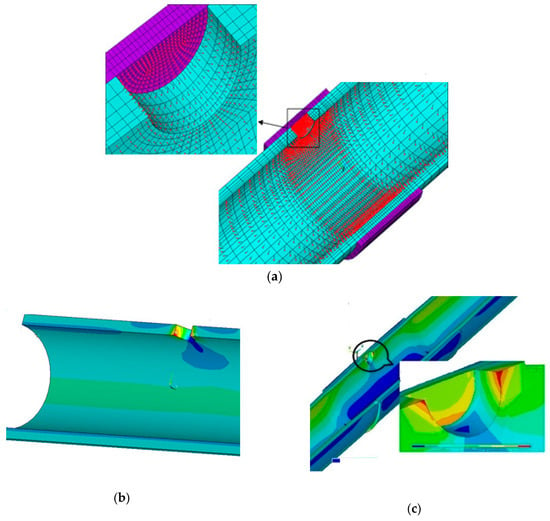 Figure 8. Finite element modeling of sectioned pipe and socket to show Von Mises stress distribution. (a) Mesh generation and the application of internal pressure. (b) Stress distribution in PE pipe with 1″ diameter circular hole. (c) Stress distribution in PE pipe and patch.
Figure 8. Finite element modeling of sectioned pipe and socket to show Von Mises stress distribution. (a) Mesh generation and the application of internal pressure. (b) Stress distribution in PE pipe with 1″ diameter circular hole. (c) Stress distribution in PE pipe and patch.
Based on these results, the selected mesh type, finite elements, loading conditions, and applied boundary conditions in this section are appropriate for carrying out the next stages of the research and can be used to perform finite element modeling of the other three types of patch arrangements which will be discussed in the next section. Additionally, in order to obtain accurate results the value of 1.5 m is used for the pipe length in the next modeling stages.
Comparing the Results of Different Patch Arrangements
Before investigating and discussing the complicated problem of buried patch repaired pipelines, for the better understanding, we decide to evaluate the efficiency of the patch repair in the reinforcement of the defected unburied pipe. Four different patch arrangements in the form of semi-cylindrical, circular-partial, square-partial and saddle fusion patches are modeled and discussed. The same procedure described in previous section is followed and used to calculate the maximum stresses in the patch and pipe loaded to an internal gas pressure of 4 bar. The number of finite elements used in this study to model unburied pipe and its patch for various patch arrangements are presented in Table 5.

Table 5.
Number of finite elements used to model unburied pipe and its patch for various patch arrangements.
The plotted curves in Figure 9 show the variation of maximum Von Mises stress in the defected patch repaired PE pipe for each kind of patch arrangement and also in unrepaired defected pipe, versus various hole diameters in the pipe. Additionally, the reduction percentage in maximum stress values resulted from the application of a special patch repair are shown and compared in Table 6.
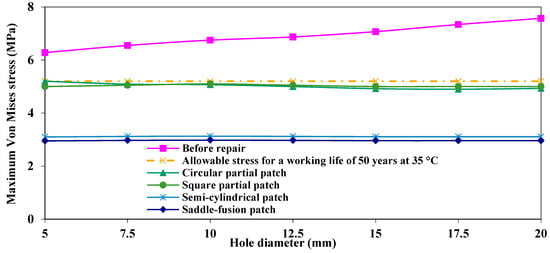
Figure 9.
Curves for maximum Von Mises stresses in various patch arrangements for unburied pipe and patch arrangement.

Table 6.
Maximum Von Mises stress reduction percentage in the holed pipe for various patch arrangements under internal pressure.
- All four patch arrangements have significant effect on the reduction of the maximum Von Mises stresses in the reinforcement of the damaged section of the pipe.
- The results of Table 6 show that the percentage of the maximum Von Mises stress reduction in the pipe increases for larger hole diameters.
- The most effective patch in the reinforcement of the pipe is saddle fusion arrangement which reduces the maximum Von Mises stresses about 48%. For square-partial patch, although the effect is notable, it is less than the other 3 kinds of patches. This patch reduces the maximum Von Mises stresses by about 8%.
- The aforementioned curves indicate that semi-cylindrical patch and saddle fusion patch show similar trends. Additionally, the results of circular-partial patch and square-partial patches are close to each other.
- It can be implied that, the reinforcement effect of semi-cylindrical patch and saddle fusion patch are significantly more than the other two patch arrangements.
4.2.2. Finite Element Modeling and Solution for a Buried Patch Repaired Pipe with Circular Wall Holes
In this section we continue to investigate the studies in [9,10] with more details and under more critical loading conditions by superimposing various thermal loads in the form of temperature variations and the mechanical loads including surcharge loads, soil column weight, soil-pipe interaction and inside pressure of 4 bar applied to the repaired defected polyethylene pipe and its patch. The trench dimensions and pipe surroundings are selected based on Figure 10. Also, soil grades which are selected based on ASTM standards along with model dimensions are depicted on the computer simulation model in Figure 10.
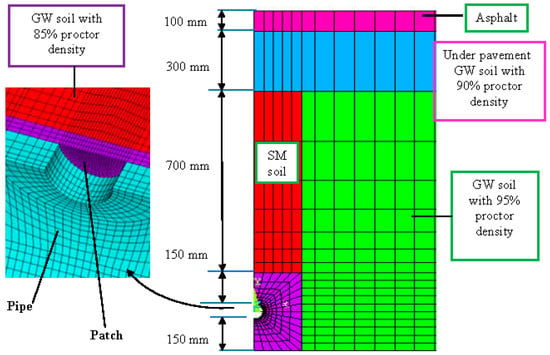
Figure 10.
Finite element model of the patched pipe with surrounding soil subjected too internal pressure. GW: Well-graded gravels; SM: Silty sands [11].
The results of previous section show that the maximum Von Mises stress values are well below the allowable stresses (based on the design factor of 1.5) for working life of 50 years at 35 °C. Additionally lower values of safety factor (design factor) are applicable to design underground gas pipes. By selecting the value of 1.25 for safety factor, the values of allowable stresses for working life of 50 years at 35 °C will be 5.2 MPa and 6.5 MPa for PE80 pipe and PE100 patch materials respectively. We prefer to use these values for the following section of the research. In order to perform a proper finite element study on the underground structure, it is important to find an appropriate model dimension which the obtained results not to be dependent on the model size. Therefore, the finite element simulation of various model sizes are calculated and compared in Table 7.

Table 7.
Simultaneous effect of soil column weight and internal pressure on maximum hoop and Von Mises stresses in defected pipe and patch for various x and z values.
The results of maximum Von Mises and hoop stresses in the pipe and its patch show that the upper surface dimension of z × x = (1.5 m) × (1.5 m) is appropriate to perform finite element modeling of this research, since larger models will not affect the stress values significantly.
The Simultaneous Effects of Thermo-Mechanical Loads on Semi-Cylindrical Patch Arrangement
Figure 11 shows the variations in the maximum values of Von Mises stresses in the buried PE80 pipe that is repaired by a 76.2 mm long semi-cylindrical patch arrangement, versus defect sizes in the form of circular holes under simultaneous effects of mechanical loads in the form of soil load, 4 bar internal pressure, vehicle wheel load and various thermal loads in the form of daily and seasonal temperature variations.
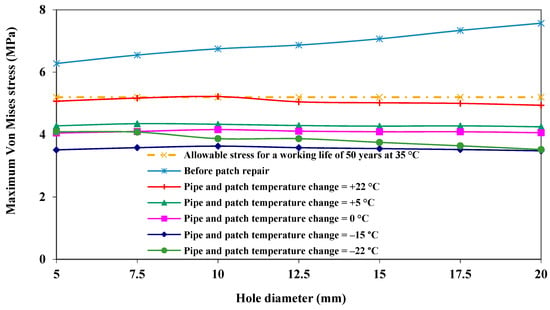
Figure 11.
Maximum Von Mises stress variations in the buried pipe for various size circular hole defects repaired by semi-cylindrical patch (the simultaneous effect of soil load, internal pressure, vehicle wheel load and temperature variations).
The upmost curve shows the values of maximum Von Mises stress for the defected pipe before the application of patch repair and indicates that increasing hole diameter increases the maximum Von Mises stress significantly. The comparison of this curve with allowable stress value for a working life of 50 years (dashed line) shows that the imposed stresses in defected pipe are significantly higher than allowable stress values. For the other four curves which show the maximum Von Mises stress values in the defected polyethylene pipe repaired by semi-cylindrical patch, the stress values are well below the results of unrepaired defected pipe and also well below the allowable stress value. This means the aforementioned patch repair can strengthen the defected part of the pipe as well to transfer the gas fuel. Additionally, for the investigated defects at a constant temperature variation, the maximum Von Mises stresses remain approximately constant even by increasing the hole size. The curves for −22 °C, −15 °C, 0 °C (no temperature changes), +5 °C, and +22 °C temperature changes shows approximately similar trend with hole diameter increase where for these cases the minimum Von Mises stresses are not increasing significantly for larger hole sizes. Generally stating, the maximum Von Mises stresses in the pipe increases for higher temperature increases. That means the patch is more effective in reinforcing defected pipe for lower temperature changes. For example, for a fixed hole diameter of 20 mm, the stress reduction percentage in the pipe wall are 53%, 53%, 46%, 44%, and 35% for the temperature changes of −22 °C, −15 °C, 0 °C, +5 °C, and +22 °C respectively. Also, the patch is more effective in reinforcing defected pipe for larger hole diameters. The maximum stress values are related to the seasonal temperature increase of +22 °C.
Additionally, Figure 12 presents maximum values of Von Mises stresses in the 3″ long semi-cylindrical patch arrangement versus pipe circular hole diameters under simultaneous effects of mechanical loads and various thermal loads in the form of daily and seasonal temperature variations. Based on the obtained results, the temperature variations have a significant effect on the maximum Von Mises stresses in the semi-cylindrical patch itself. The lowest curve on Figure 12 which shows the lowest values of maximum Von Mises stresses belongs to the situation where no temperature change is imposed to the pipe and patch at the burial depth under the ground that means it is the case with the minimum valves of the induced maximum Von Mises stresses compared to the other temperature changes. Additionally, the uppermost curve fits the data obtained for the maximum temperature change (+22 °C temperature increase, based on seasonal variations), which shows the case with highest values of induced maximum Von Mises stresses among others. For the semi-cylindrical PE100 patch material it can be implied that higher temperature changes (both temperature increase and temperature decrease) impose higher maximum Von Mises stresses. Also, for the cases of low temperature changes including 0 °C, +5 °C, the maximum Von Mises stresses in the patch show an increase trend by increasing the pipe hole diameter, while for the cases of higher values of temperature changes including −15 °C, −22 °C, +22 °C the maximum Von Mises stresses will remain approximately constant even for larger hole diameters. Based on the calculated results, the semi-cylindrical patch can reinforce the proposed circular hole modeled defects efficiently. The only problem is that for higher temperature changes, the maximum Von Mises stress values in the patch itself can be critical which requires more research and investigation on the other patch configurations.
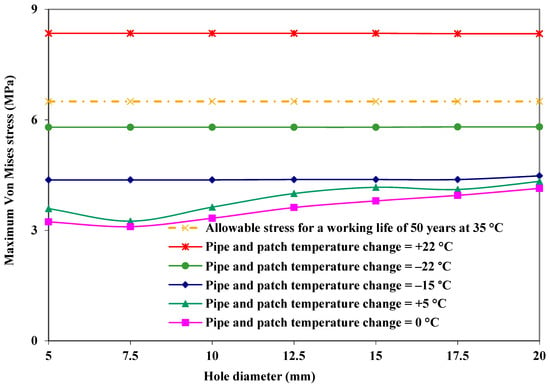
Figure 12.
Maximum Von Mises stress in the semi-cylindrical patch for various sizes of circular hole defects (the simultaneous effect of mechanical and thermal loads).
The Simultaneous Effects of Thermo-Mechanical Loads on Circular Partial Patch Arrangement
In this section in order to more investigate to find a proper patch, a circular partial patch arrangement is designed and its reinforcing effect on the damaged underground PE gas pipe are being studied. The results of the FE simulation in the form of variations in the maximum values of Von Mises stresses in the buried PE80 pipe that is repaired by the circular partial patch arrangement, versus defect sizes in the form of circular hole under simultaneous effects of the previously mentioned mechanical loads and various thermal loads are depicted in Figure 13.
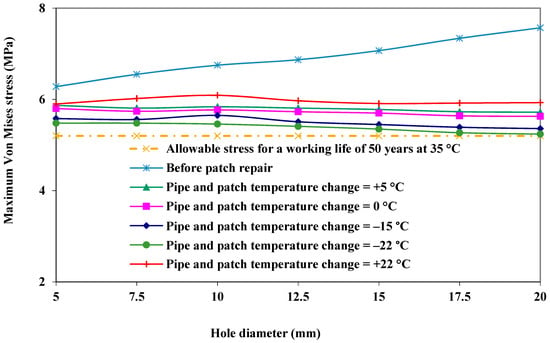
Figure 13.
Maximum Von Mises stress variations in the buried pipe for various size circular hole defects repaired by circular partial patch (the simultaneous effect of soil load, internal pressure, vehicle wheel load and temperature variations).
Similar to the previous case, as expected the upmost curve is related to the values of maximum Von Mises stresses for the defected pipe prior to circular-partial patch application and shows that for larger hole diameters, the maximum Von Mises stress increases significantly. Based on the results of the other five presented curves which shows the maximum Von Mises stresses in the defected polyethylene pipe repaired by circular-partial patch and comparing these curves with dashed line that indicates allowable stress values, the imposed stress values are well below the results of unrepaired defected pipe but slightly above the allowable stress values. Considering the case of 20 mm hole diameter, the stress reduction percentage in the pipe wall are 31%, 29%, 26%, 24%, and 22% for the temperature changes of −22 °C, −15 °C, 0 °C, +5 °C, and +22 °C respectively. The results imply that for the application of the aforementioned patch repair to reinforce the damaged part of the pipe some stress relief mechanisms must be employed too. Additionally, for the investigated defects at a constant temperature variation, the maximum on Mises stresses remain approximately constant even by increasing the hole size. The curves for −22 °C, −15 °C, 0 °C, +5 °C, and +22 °C temperature changes shows approximately similar trend with hole diameter increase. The maximum stress values are related to the seasonal temperature increase of +22 °C.
Additionally, the maximum values of Von Mises stresses in the circular partial patch arrangement versus pipe circular hole diameters under simultaneous effects of aforementioned mechanical loads and various thermal loads in the form of daily and seasonal temperature variations are presented in Figure 14. According to the obtained results, the temperature variations have significant effect on the maximum Von Mises stress variations in the circular partial patch. The lowest curve on Figure 14 belongs to the situation where no temperature change is imposed to the pipe and patch at the burial depth under the ground that means it is the case with the minimum valves of the induced maximum Von Mises stresses. Additionally, the uppermost curve fits the data obtained for the maximum temperature change (+22 °C temperature decrease, based on seasonal variations), which shows the case with highest values of induced maximum Von Mises stresses among others. For the circular partial PE100 patch material it can be implied that higher temperature changes (both temperature increase and temperature decrease) impose higher maximum Von Mises stresses.
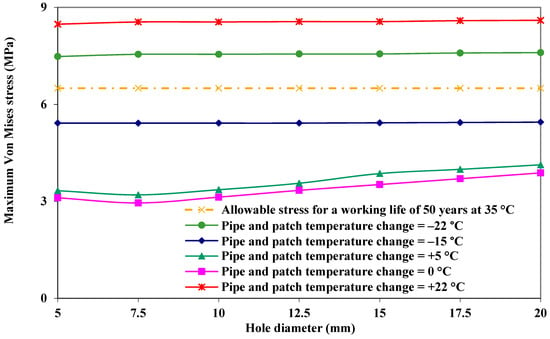
Figure 14.
Maximum Von Mises stress in the circular partial patch for various sizes of circular hole defects (the simultaneous effect of mechanical and thermal loads).
For higher temperature changes, including a +22 °C temperature increase and a −22 °C temperature decrease, the maximum Von Mises stresses are above the allowable stress which means applying circular partial patches in these areas cannot be suggested. For lower temperature changes including −15 °C, 0 °C, and +5 °C the maximum Von Mises stresses are well below the allowable stress limit, which means the circular partial patch is applicable in the areas with the temperature changes up to the mentioned values.
The Simultaneous Effects of Thermo-Mechanical Loads on Square Partial Patch Arrangement
The same procedure which was discussed for semi-cylindrical and circular partial patches in the two previous sections is used to investigate square partial patch arrangement by finite element method. The results of Ansys simulation for the variations in the maximum values of Von Mises stresses in the buried PE80 pipe that is repaired by a square partial patch arrangement, versus defect sizes in the form of circular hole under simultaneous effects of mechanical loads in the form of soil load, 4 bar internal pressure, vehicle wheel load, and various thermal loads in the form of daily and seasonal temperature variations are depicted in Figure 15.
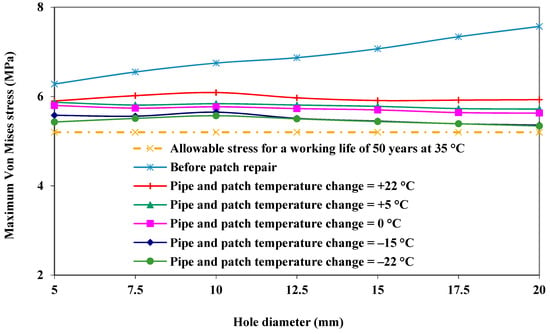
Figure 15.
Maximum Von Mises stress variations in the buried pipe for various sizes of circular hole defects repaired by square partial patch (the simultaneous effect of soil load, internal pressure, vehicle wheel load and temperature variations).
Comparing the curves showing the results of maximum Von Mises stress values for various temperature changes and the upmost curve which is related to the defected unrepaired pipe, shows that square-partial patch arrangement plays an important role in decreasing maximum stress values and strengthening the defected part of the pipe. For more understanding, considering the case of the 20 mm hole diameter, the results show the stress reduction percentage in the pipe wall are 29.5%, 29.2%, 25.6%, 24.3%, and 21.7% for the temperature changes of −22 °C, −15 °C, 0 °C, +5 °C, and +22 °C respectively, which shows that patch has more reinforcing effects for lower temperature changes. Even though, the square-partial patch has significant effect on reinforcing the defected pipe and decreasing the maximum Von Mises stress values, but comparing the results with the dashed line of allowable stress shows that the induced maximum Von Mises stresses are slightly higher than allowable stress values. Therefore, if we decide to use this kind of patch, more researches should be conducted to obtain some stress relief mechanisms. Additionally, the curves show similar trends for different temperature changes. Furthermore, comparing these curves with the results obtained for circular-partial patch shows approximately similar trends between these two cases.
Additionally, the maximum values of Von Mises stresses in the square partial patch arrangement versus pipe circular hole diameters under simultaneous effects of aforementioned mechanical loads and various thermal loads in the form of daily and seasonal temperature variations are presented in Figure 16. As can be implied, the temperature variations have a significant effect on the variation of the maximum Von Mises stresses in the square partial patch. The lowest curve on Figure 16 belongs to the situation where no temperature change is imposed to the pipe and patch at the burial depth under the ground that means it is the case with the minimum valves of the induced maximum Von Mises stresses. Additionally, uppermost curve fits the data obtained for the maximum temperature change (+22 °C temperature increase, based on seasonal variations), which shows the case with highest values of induced maximum Von Mises stresses among others. It is clear that for low temperature changes, including 0 °C and +5 °C, the maximum Von Mises stresses in the patch increases for larger hole diameters. For higher temperature changes including −15 °C, −22 °C, and +22 °C the results will remain approximately constant even by increasing hole diameter. For the square partial PE100 patch material it can be implied that higher temperature changes (both temperature increase and temperature decrease) impose higher maximum Von Mises stresses. The curves showing the data of patch stress results are below the allowable stress of the patch material except for the case of +22 °C temperature increase.
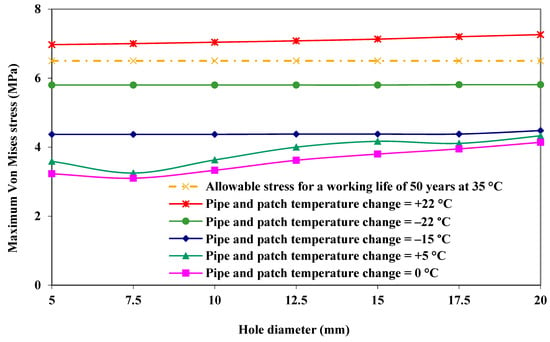
Figure 16.
Maximum Von Mises stress in the square partial patch for various sizes of circular hole defects (the simultaneous effect of mechanical and thermal loads).
The Simultaneous Effects of Thermo-Mechanical Loads on Saddle Fusion Patch Arrangement
In the previous parts, three patch repair configurations were introduced and discussed in details. Finite element solutions for investigating the stress distribution in the aforementioned patch repairs to find the effectiveness of the proposed patch arrangements gave us the knowledge that semi-cylindrical patch configuration can effectively reinforce the defected part of the pipe. For the sake of finding a more reliable patch configuration we decide to investigate a full-cylindrical (called saddle fusion) patch repair. In order to verify the finite element model dimension, in Section 4.2.2 the variation of maximum Von Mises stresses in the repaired defected buried polyethylene gas pipe and its 3 inch long, saddle fusion patch under mechanical loads is well discussed. Figure 17 shows the variations in the maximum values of Von Mises stresses in the buried PE80 pipe that is repaired by a saddle fusion patch arrangement, versus defect sizes in the form of circular hole under simultaneous effects of mechanical loads in the form of soil load, 4 bar internal pressure, vehicle wheel load, and various thermal loads in the form of daily and seasonal temperature variations. The comparison of the curves resulted from saddle fusion patch repair for various temperature changes of −22 °C, −15 °C, 0 °C, +5 °C, and +22 °C with the upmost curve which shows the maximum Von Mises stress values for defected pipe before repair shows that the saddle fusion patch repair effectively reinforces the damaged part of the pipe to reliably transfer the gas. Additionally, comparing the mentioned five curves with the dashed line that indicates allowable stress values for PE80 pipe material shows that the maximum Von Mises stress values are well below the allowable stress. For more clarification considering the case of 20 mm hole diameter, the results show the stress reduction percentage in the pipe wall are 54%, 56%, 45%, 43%, and 36% for the temperature changes of −22 °C, −15 °C, 0 °C, +5 °C, and +22 °C respectively. All the five curves show similar trends.
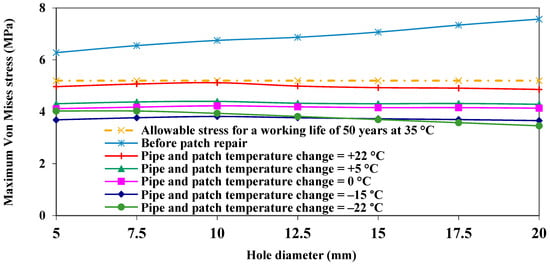
Figure 17.
Maximum Von Mises stress in buried pipe for circular hole defects, saddle fusion patch repaired (simultaneous effects of soil load, internal pressure, vehicle load and temperature variations).
Figure 18 presents maximum values of Von Mises stresses in the 3 inch long, saddle fusion patch arrangement versus pipe circular hole diameters under simultaneous effects of previously mentioned mechanical and various discussed thermal loads. The obtained results show that, the temperature variations have significant effect on the maximum Von Mises stresses in the saddle fusion patch. similar to the 3 previously discussed patch arrangements the lowest curve on Figure 18 belongs to the situation where no temperature change is imposed to the pipe and patch at the burial depth under the ground that means it is the case with the minimum valves of the induced maximum Von Mises stresses. Additionally, the uppermost curve fits the data obtained for the maximum temperature change (+22 °C temperature increase, based on seasonal variations), which shows the case with highest values of induced maximum Von Mises stresses among others. For the saddle fusion PE100 patch material it can be implied that higher temperature changes (both temperature increase and temperature decrease) impose higher maximum Von Mises stresses. For all curves, the maximum Von Mises stress values in the patch will increase for larger hole diameters. For all cases, the maximum Von Mises stresses are well below the allowable stress limit for PE100 material which means the saddle fusion patch is well applicable to repair the proposed defects in even hot areas. Therefore, the results show the application of 3” saddle fusion patch is advisable for the proposed loading condition.
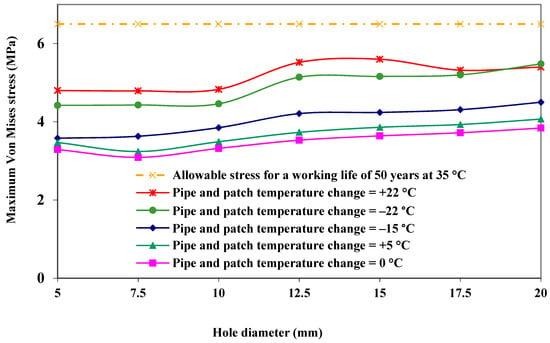
Figure 18.
Maximum Von Mises stress in 3 inch long, saddle fusion patch for various sizes of circular hole defects (the simultaneous effect of mechanical and thermal loads).
5. Conclusions
In the present contribution a simple and effective computational method is developed to treat actual industrial fully three-dimensional complicated problems of large underground space. The finite element method is used to investigate stress distribution in buried gas pipe subjected to thermo-mechanical loads and stress concentrations due to changes in the geometry. This study was divided in two parts. In the first case, stress values were calculated for the socket joint of the buried PE pipe so that by applying the proper pipe joints, the stress be reduced to levels below the allowable values. For the second part, the effects of thermo-mechanical loads on the stress distribution in patch repaired buried pipes are well investigated. For this purpose, in this research, 3D finite element modeling of buried gas pipe and its socket/patch is performed using ANSYS software. Stress variations in the buried MDPE gas pipe and high density polyethylene (HDPE) socket/patch were fully investigated in a hot climate region to determine the critical stress values caused by stress concentrations at the pipe and socket/patch, enabling us to find the applicable method for joining or repairing MDPE gas transportation piping in such areas. The optimum burial depth was found to be 1.25 m, while the maximum and minimum ground surface temperatures at this depth were calculated to be 35 °C and 13 °C, respectively. Furthermore, the soil column weight above the pipe, the surcharge loads in terms of traffic load, the gas pressure of 4 bar inside the pipe and the stress concentrations due to a local change in geometry (in the form of damage) were imposed on the pipe and its socket/patch resulting in the following conclusions:
By considering the obtained plots for stress values in buried pipe and its socket and comparing it with allowable stress values for the pipe, the correct joining method can be investigated. Based on the results, maximum Von Mises stresses occurs at the middle of the socket internal surface while the maximum values of the aforementioned stresses in the socket occur where the internal surface of the socket joins the pipe outer surface. In both pipe and socket the maximum values of the aforementioned stresses are well below the allowable stresses and therefore the introduced socket joint can be used under the described working condition. Additionally, for the problem of the patch repaired buried pipes, the results show that all four patch configurations have significant reinforcing effect on the defected section of the buried pipe under the aforementioned thermo-mechanical loads. Meanwhile, the maximum Von Mises stresses in both pipe and saddle fusion patch are well below the allowable stress limit for PE material which means the saddle fusion patch is well applicable to repair the proposed defects in even hot areas. Therefore, the results show the application of introduced socket and also saddle fusion patch is advisable for the proposed loading condition.
Author Contributions
The two authors contributed to perform this research. R.K.-Z. conceived of the presented idea, developed the theory, created the ANSYS models, calculated mechanical stress on the models and discussed the results. P.A. gave feedback in all steps of the research work, made a critical review of the paper and also applied standards to use in this project.
Funding
This research received no external funding.
Acknowledgments
The first author highly appreciated prevalent help of his late friend Ali Nasirian for sharing his knowledge and experience in Finite Element modeling of underground space. His memory will be with me always.
Conflicts of Interest
The authors declare no conflict of interest.
Abbreviations
| C | Design coefficient |
| Di | Pipe inside diameter (mm) |
| Do | Pipe outside diameter (mm) |
| E | Elastic modulus (MPa) |
| h | Pipe thickness (mm) |
| l | Pipe length in the model (mm) |
| MRS | Maximum reduced strength (MPa) |
| pi | Pipe inside pressure (mm) |
| SDR | Standard dimension ratio (SDR = ) |
| t | Time (sec) |
| T(y,t) | Induced temperature in the soil (°C) |
| y | Depth of the pipe (cm or mm) |
| α | Thermal diffusivity (cm2/s) at penetration depth |
| Temperature change (°C) | |
| ν | Poisson’s ratio |
| σ | Normal stress in the pipe (MPa) |
| σe | Von Mises stress (MPa) |
| σθθ | Tangential stress in the pipe (MPa) |
| σrr | Radial stress in the pipe (MPa) |
| σzz | Longitudinal stress in the pipe (MPa) |
References
- Khademi-Zahedi, R.; Makvandi, M.; Shishesaz, M. Technical analysis of the failures in a typical drilling mud pump during field operation. In Proceedings of the 22nd Annual International Conference on Mechanical Engineering—ISME2014, Ahvaz, Iran, 22–24 April 2014; Available online: https://www.civilica.com/Paper-ISME22-ISME22_347.html (accessed on 18 October 2018).
- Khademi-Zahedi, R.; Makvandi, M.; Shishesaz, M. The applicability of casings and liners composite patch repair in Iranian gas and oil wells. In Proceedings of the 22nd Annual International Conference on Mechanical Engineering—ISME2014, Ahvaz, Iran, 22–24 April 2014; Available online: https://www.civilica.com/Paper-ISME22-ISME22_351.html (accessed on 18 October 2018).
- Makvandi, M.; Bahmani, H.; Khademi-Zahedi, R. Technical analysis of the causes of blowout in BiBiHakimeh well No. 76. In Proceedings of the National Conference in New Research of Industry and Mechanical Engineering, Tehran, Iran, 17–18 September 2015; Available online: https://www.civilica.com/Paper-NRIME01-NRIME01_066.html (accessed on 18 October 2018).
- Sampaio, J.H.B., Jr. Drilling Engineering Fundamentals. Master’s Thesis, Curtin University Technology, Bentley, Australia, 2007. [Google Scholar]
- AASHTO Standard Specifications for Transportation Materials and Methods of Sampling and Testing, 15th ed.; American Association of State Highway and Transportation Officials: Washington, DC, USA, 1990.
- Moser, A.P.; Folkman, S. Buried Pipe Design; Book 2—Chapter 7; The McGraw-Hill Companies, Inc.: New York, NY, USA, 2001; 900p. [Google Scholar]
- Goddard, J.B. Plastic Pipe Design; Technical Report 4.103; Advanced Drainage Systems, Inc.: Hilliard, OH, USA, 1994; pp. 1–30. [Google Scholar]
- Khademi-Zahedi, R. Stress Distribution in Patch Repaired Polyethylene Gas Pipes. Master’s Thesis, Shahid Chamran University, Ahvaz, Iran, 2011. [Google Scholar]
- Khademi-Zahedi, R. Application of the finite element method for evaluating the stress distribution in burried damaged polyethylene gas pipes. Undergr. Space 2018. [Google Scholar] [CrossRef]
- Khademi-Zahedi, R.; Shishesaz, M. Application of a finite element method to stress distribution in buried patch repaired polyethylene gas pipe. Undergr. Space 2018. [Google Scholar] [CrossRef]
- Nasirian, A. Investigating the Application of Polyethylene Gas Pipes for Gas Transportation. Master’s Thesis, Shahid Chamran University, Ahvaz, Iran, 2007. [Google Scholar]
- Shishesaz, M.; Shishesaz, M.R. Applicability of medium density polyethylene Gas Pipes in Hot Climate Areas of South-West Iran. Iran. Polym. J. 2008, 17, 503–517. [Google Scholar]
- Khademi-Zahedi, R.; Shishesaz, M.; Karamy-Moghadam, A.; Veisi-Ara, A. Stress analysis in defected buried polyethylene pipes for gas distribution networks. In Proceedings of the National Conference in New Research of Industry and Mechanical Engineering, Tehran, Iran, 17–18 September 2015. [Google Scholar]
- Plastic Pipe and Building Products. In ASTM Annual Book of ASTM Standards; American Society for Testing and Material: Philadelphia, PA, USA, 1991.
- The Plastics Pipe Institute. Handbook of Polyethylene Pipe; Plastics Pipe Institute, Inc.: Washington, DC, USA, 2006; Chapter 6; pp. 157–260. [Google Scholar]
- Corrugated Polyethylene Pipe Association. Structural Design Method for Corrugated Polyethylene Pipe; Corrugated Polyethylene Pipe Association: Washington, DC, USA, 2000. [Google Scholar]
- European Standard. EN1555-2, Plastic Piping Systems for the Supply of Gaseous Fuels-Polyethylene (PE)-Part 2: Pipes, European Committee for Standardization. Available online: https://webstore.ansi.org/RecordDetail.aspx?sku=DIN+EN+1555-2%3A2010 (accessed on 18 October 2018).
- Plastic Pipe Institute. Polyethylene Gas Pipes Systems, Uponor Aldyl Company Installation Guide; Plastics Pipe Institute: Washington, DC, USA, 2004. [Google Scholar]
- Egan, B.; Qenos, A.H. PE100, and Its Advantages When Used for Ploughing & Trenchless Technology. Available online: www.masterplumbers.com/plumbwatch/pipes99/pe100.doc (accessed on 18 October 2018).
- Tabatabaii, A.; Ameri, M.; Behbahani, H. Prediction of Asphalt Cover Temperature in City of Ahvaz (Iran). J. Eng. 1999, 7, 22. (In Persian) [Google Scholar]
- International Organization for Standardization. ISO12162, Thermo plastics Materials for Pipes and Fittings for Pressure Applications–Classification and Designation–Overall Service (Design) Coefficient. Available online: https://www.iso.org/standard/43865.html (accessed on 18 October 2018).
- Amiri, F.; Milan, D.; Shen, Y.; Rabczuk, T.; Arroyo, M. Phase-field modeling of fracture in linear thin shells. Theor. Appl. Fract. Mech. 2014, 69, 102–109. [Google Scholar] [CrossRef]
- Areias, P.; Rabczuk, T. Finite strain fracture of plates and shells with configurational forces and edge rotation. Int. J. Numer. Methods Eng. 2013, 94, 1099–1122. [Google Scholar] [CrossRef]
- Areias, P.; Rabczuk, T. Steiner-point free edge cutting of tetrahedral meshes with applications in fracture. Finite Elem. Anal. Des. 2017, 132, 27–41. [Google Scholar] [CrossRef]
- Areias, P.; Msekh, M.A.; Rabczuk, T. Damage and fracture algorithm using the screened Poisson equation and local remeshing. Eng. Fract. Mech. 2016, 158, 116–143. [Google Scholar] [CrossRef]
- Areias, P.; Rabczuk, T.; Msekh, M. Phase-field analysis of finite-strain plates and shells including element subdivision. Comput. Methods Appl. Mech. Eng. 2016, 312, 322–350. [Google Scholar] [CrossRef]
- Areias, P.M.A.; Rabczuk, T.; Camanho, P.P. Finite strain fracture of 2D problems with injected anisotropic softening elements. Theor. Appl. Fract. Mech. 2014, 72, 50–63. [Google Scholar] [CrossRef]
- Chau-Dinh, T.; Zi, G.; Lee, P.S.; Song, J.H.; Rabczuk, T. Phantom-node Method for Shell Models with Arbitrary Cracks. Comput. Struct. 2012, 92–93, 242–256. [Google Scholar] [CrossRef]
- Ghorashi, S.; Valizadeh, N.; Mohammadi, S.; Rabczuk, T. T-spline based XIGA for Fracture Analysis of Orthotropic Media. Comput. Struct. 2015, 147, 138–146. [Google Scholar] [CrossRef]
- Hamdia, K.; Zhuang, X.; Silani, M.; He, P.; Rabczuk, T. Stochastic analysis of the fracture toughness of polymeric nanoparticle composites using polynomial chaos expansions. Int. J. Fract. 2017, 206, 215–227. [Google Scholar] [CrossRef]
- KhademiZahedi, R.; Alimouri, P.; Nguyen-Xuan, H.; Rabczuk, T. Crack detection in a beam on elastic foundation using differential quadrature method and the Bees algorithm optimization. Proc. Int. Conf. Adv. Comput. Mech. 2017, 36, 439–460. [Google Scholar]
- Nguyen-Thanh, N.; Kiendl, J.; Nguyen-Xuan, H.; Wuchner, R.; Bletzinger, K.U.; Bazilevs, Y.; Rabczuk, T. Rotation free isogeometric thin shell analysis using PHT-splines. Comput. Methods Appl. Mech. Eng. 2011, 200, 3410–3424. [Google Scholar] [CrossRef]
- Nguyen-Thanh, N.; Valizadeh, N.; Nguyen, M.N.; Nguyen-Xuan, H.; Zhuang, X.; Areias, P.; Zi, G.; Bazilevs, Y.; De Lorenzis, L.; Rabczuk, T. An extended isogeometric thin shell analysis based on Kirchhoff-Love theory. Comput. Methods Appl. Mech. Eng. 2015, 284, 265–291. [Google Scholar] [CrossRef]
- Nguyen-Thanh, N.; Zhou, K.; Zhuang, X.; Areias, P.; Nguyen-Xuan, H.; Bazilevs, Y.; Rabczuk, T. Isogeometric analysis of large-deformation thin shells using RHT-splines for multiple-patch coupling. Comput. Methods Appl. Mech. Eng. 2017, 316, 1157–1178. [Google Scholar] [CrossRef]
- Rabczuk, T. Computational Methods for Fracture in Brittle and Quasi-Brittle Solids: State-of-the-art Review and Future Perspectives. ISRN Appl. Math. 2013, 2013, 849231. [Google Scholar] [CrossRef]
- Rabczuk, T.; Areias, P.M.A.; Belytschko, T. A meshfree thin shell method for non- linear dynamic fracture. Int. J. Numer. Methods Eng. 2007, 72, 524–548. [Google Scholar] [CrossRef]
- Rabczuk, T.; Gracie, R.; Song, J.H.; Belytschko, T. Immersed particle method for fluid-structure interaction. Int. J. Numer. Methods Eng. 2010, 81, 48–71. [Google Scholar] [CrossRef]
- Ren, H.; Zhuang, X.; Cai, Y.; Rabczuk, T. Dual-Horizon Peridynamics. Int. J. Numer. Methods Eng. 2016, 108, 1451–1476. [Google Scholar] [CrossRef]
- Ren, H.; Zhuang, X.; Rabczuk, T. Dual-horizon peridynamics: A stable solution to varying horizons. Comput. Methods Appl. Mech. Eng. 2017, 318, 762–782. [Google Scholar] [CrossRef]
- KhademiZahedi, R.; Alimouri, P. Finite element model updating of a large structure using multi-setup stochastic subspace identification method and bees optimization algorithm. Front. Struct. Civ. Eng. 2018, in press. [Google Scholar]
- J-M Manufacturing Company Inc. International MDPE Yellow Gas Pipe. Available online: http://www.jmeagle.com/sites/default/files/Products_MDPE%20Yellow%20Gas.pdf (accessed on 6 December 2017).
© 2018 by the authors. Licensee MDPI, Basel, Switzerland. This article is an open access article distributed under the terms and conditions of the Creative Commons Attribution (CC BY) license (http://creativecommons.org/licenses/by/4.0/).